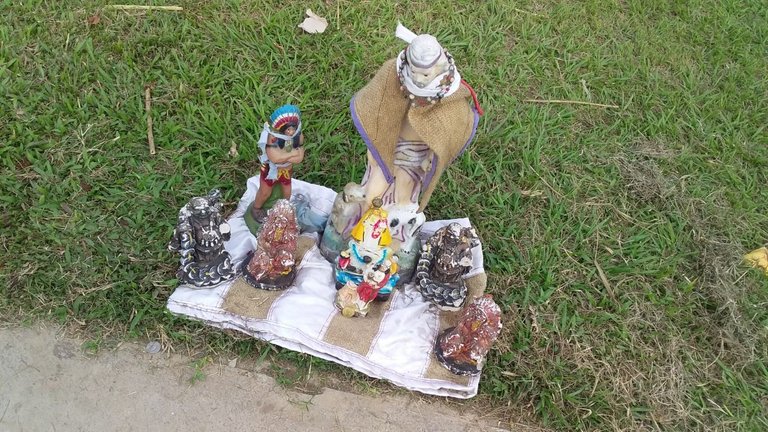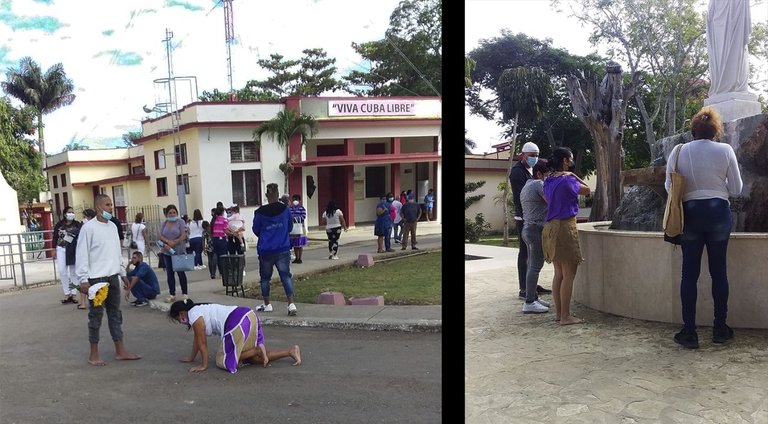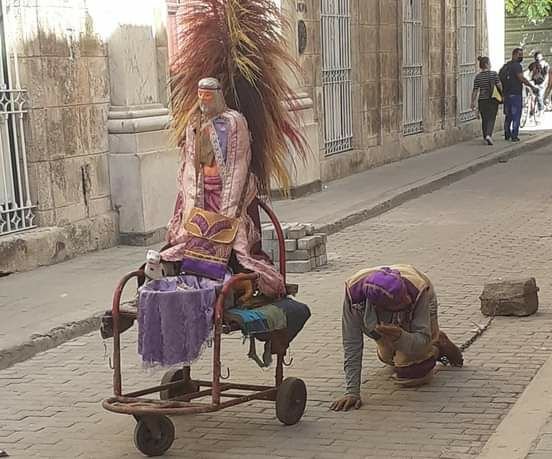«Siete días con siete noches, por el mundo caminando, y no encuentro una limosna, pa mi viejo Babalú Ayé.»
"Seven days and seven nights, walking around the world, and I can't find a handout, for my old Babalú Ayé."
 Figurillas a la entrada del Santuario
Figurillas a la entrada del Santuario
FOTO ORIGINAL DEL CANAL
Desde el día 16 de diciembre en la tarde-noche comienza la peregrinación al Santuario Nacional del Santo Milagroso. Los devotos cargan velas blancas y moradas, exuberantes ramos de flores violáceos y visten de saco. Muchos entran descalzos, otros arrastrándose por el suelo o de rodillas dejando atrás un rastro de sangre leve producto a la rotura de la piel.
Algunos van a adorar al Lázaro al que Jesús le devolvió la vida, al Lázaro pobre que llegó a casa del hombre rico, con dos perros que le lamían las llagas de las piernas producidas por la lepra. Otros llegan al lugar para adorar a Babalú Ayé, el Orisha que se sincretiza con este Santo Católico y cuyo día también corresponde al 17 de diciembre.
From December 16 in the afternoon-night the pilgrimage to the National Sanctuary of the Miraculous Saint begins. Devotees carry white and purple candles, lush bouquets of purple flowers, and dress in sackcloths. Many enter barefoot, others crawling on the ground or on their knees, leaving behind a trace of slight blood caused by the breakdown of the skin. Some go to worship the Lazarus whom Jesus brought back to life, the poor Lazarus who came to the rich man's house, with two dogs that licked the sores on his legs caused by leprosy. Others come to the place to worship Babalú Ayé, the Orisha who is syncretized with this Catholic Saint and whose day also corresponds to December 17.
 FOTO ORIGINAL DEL CANAL
FOTO ORIGINAL DEL CANAL
Cuenta un patakí yoruba que Babalú Ayé llevaba una vida de fiestas y mujeres, contraria a los mandamientos de Olofi (Dios) y por mujeriego es castigado con varias enfermedades y su cuerpo se llena de llagas, trayendo la peste a la tierra Yoruba. Fue desterrado y su hermano Shangó, que venía de tierra Arará, donde muchas enfermedades reinaban, le enseña como curar disímiles dolencias. Babalú llegó, salvó a los enfermos con los conocimientos adquiridos, fue coronado rey y llamado Azojuano. Desde ese día las personas le rezan para el alivio de todas las dolencias, tanto corporales como espirituales.
A Yoruba patakí tells that Babalú Ayé led a life of parties and women, contrary to the commandments of Olofi (God) and as a womanizer he is punished with various diseases and his body is filled with sores, bringing the plague to the Yoruba land. He was exiled and his brother Shango, who came from Arará land, where many diseases reigned, taught him how to cure dissimilar ailments. Babalú arrived, saved the sick with the acquired knowledge, was crowned king and called Azojuano. From that day on, people pray to him for the relief of all ailments, both bodily and spiritual.
 Foto Original del canal
Foto Original del canal
San Lázaro es el santo más querido y adorado en la Isla de Cuba, después de la Virgen de la Caridad del Cobre, la patrona de Cuba, que sincretiza con Oshún. Se considera uno de los santos más milagrosos. A sus pies llegan a diario promesas de todo tipo y como muestras de fe son vistos por las calles o en las cercanías del Rincón los más penosos castigos.
Saint Lazarus is the most loved and adored saint on the Island of Cuba, after the Virgen de la Caridad del Cobre, the patron saint of Cuba, who syncretizes with Oshún. He is considered one of the most miraculous saints. Promises of all kinds arrive at his feet every day and as tokens of faith the most painful punishments are seen in the streets or in the vicinity of Rincón.
 Trono yoruba en honor al Orisha Babalú Ayé.
Trono yoruba en honor al Orisha Babalú Ayé.
Yoruba throne in honor of the orisha Babalu Aye
FOTO ORIGINAL DEL CANAL
 FOTO ORIGINAL DEL CANAL
FOTO ORIGINAL DEL CANAL
Católicos, Yorubas, o quienes no tienen religión y simplemente creen en San Lázaro, juntos, le rinden culto en una sola fe, unidos como pueblo, hijos de la misma historia y frutos de las mismas raíces.
Congratulations @anibalbestard! You have completed the following achievement on the Hive blockchain and have been rewarded with new badge(s):
Your next target is to reach 1500 upvotes.
You can view your badges on your board and compare yourself to others in the Ranking
If you no longer want to receive notifications, reply to this comment with the word
STOPCheck out the last post from @hivebuzz:
Support the HiveBuzz project. Vote for our proposal!